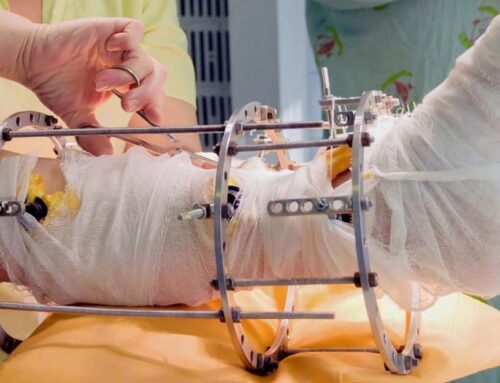External fixators are medical devices used to stabilize and immobilize bones and soft tissues outside the body, usually after a fracture or major surgery. They consist of metal pins or screws that are surgically inserted into the bone fragments on either side of a fracture, and these pins are connected to external metal rods or frames.
The key purposes of external fixators are to:
- Stabilize fractures – External fixators hold broken bones in the correct alignment, allowing them to heal properly. This is especially useful in complex fractures, open fractures (where the bone pierces the skin), and fractures with significant soft tissue damage.
- Enable soft tissue healing – Since the fixator is outside the body, it keeps the area open and accessible, which is helpful if there are injuries to surrounding soft tissues. It also reduces the risk of infection compared to internal hardware in open fractures.
- Allow for adjustable alignment – External fixators can be adjusted as the bone heals, so that any alignment issues can be corrected without additional surgery. This is particularly useful in correcting limb deformities or length discrepancies.
- Offer flexibility for complex cases – External fixators are sometimes used for bone lengthening procedures, joint fusion, and reconstructive surgery when bones need time and support to grow or align.
EXTERNAL FIXATORS’ USES
External fixators are used in various medical situations, primarily involving fractures, bone deformities, and conditions requiring stabilization or correction. Here are the main uses:
Fracture Stabilization:
- Complex fractures: They provide stable fixation for complex fractures, especially those with multiple breaks or fragments.
- Open fractures: In fractures where the bone pierces the skin, external fixators minimize infection risk by keeping the fixation outside the body and allowing for wound care.
Bone Lengthening and Deformity Correction:
- Limb lengthening: Used in procedures like the Ilizarov technique, where the bone is gradually separated to encourage new bone growth, lengthening the limb.
- Correcting angular deformities: External fixators can gradually adjust bone alignment, correcting conditions like bow legs or knock knees.
Joint Fusion and Stabilization:
- Joint fusion: In cases where a joint must be fused, such as after severe arthritis or injury, external fixators stabilize bones to allow them to grow together.
- Stabilizing unstable joints: External fixators provide support and restrict movement in joints that are temporarily unstable.
Soft Tissue and Bone Infection Management:
- For infections (osteomyelitis) that need drainage or medication delivery, external fixators allow ongoing access to affected tissues.
- They prevent further damage to infected or healing tissue by immobilizing the bone and reducing the risk of internal implant infection.
Temporary Stabilization Before Definitive Surgery:
- In severe trauma cases, especially involving multiple injuries, external fixators can stabilize bones temporarily. This approach allows time for the patient’s condition to stabilize before performing definitive surgery.
Complex Orthopedic Reconstructions:
- Used in congenital conditions, non-union fractures (fractures that fail to heal), and after bone tumor removal, external fixators can aid in reconstructing or reshaping bone structure and alignment.
EXTERNAL FIXATORS’ BENEFITS
External fixators offer several benefits in managing fractures, deformities, and other orthopedic conditions, making them a valuable option in specific situations.
Here are some key benefits:
Minimized Infection Risk:
- Since the hardware remains outside the body, external fixators are less likely to introduce infection to bones and surrounding tissues compared to internal fixation (plates or rods) in open fractures.
Accessibility for Soft Tissue Healing:
- External fixators provide open access to wounds and soft tissue, allowing doctors to treat injuries, apply wound dressings, and perform additional procedures if necessary without removing the device.
Stabilization for Complex and Severe Fractures:
- They provide a stable structure for complex fractures, including comminuted (shattered) fractures or fractures that involve multiple breaks. This stabilization helps bones heal in proper alignment and improves outcomes.
Adjustable and Adaptable:
- External fixators can be adjusted externally without the need for additional surgeries, allowing doctors to correct alignment or lengthen bones gradually if needed. This flexibility is especially beneficial for deformity corrections and limb lengthening.
Temporary Solution for Trauma Patients:
- In cases where a patient is too medically unstable for a major surgery, external fixators can stabilize fractures temporarily until the patient is ready for a more definitive surgical procedure.
Minimized Soft Tissue Disruption:
- By keeping the fixation external, these devices avoid additional disruption to muscles, blood vessels, and nerves, which helps reduce pain and speeds up recovery in certain cases.
Enables Bone Regrowth and Remodeling:
- In procedures like limb lengthening or correcting deformities, external fixators can be used to stimulate new bone growth by slowly separating bone segments, encouraging the body to generate new bone tissue in the gap.
Effective in Managing Infected or Non-Union Fractures:
- In cases where bones fail to heal (non-union) or there is chronic infection (osteomyelitis), external fixators provide stability while allowing ongoing access to the site for treatments, making them ideal for these challenging cases.




Leave A Comment